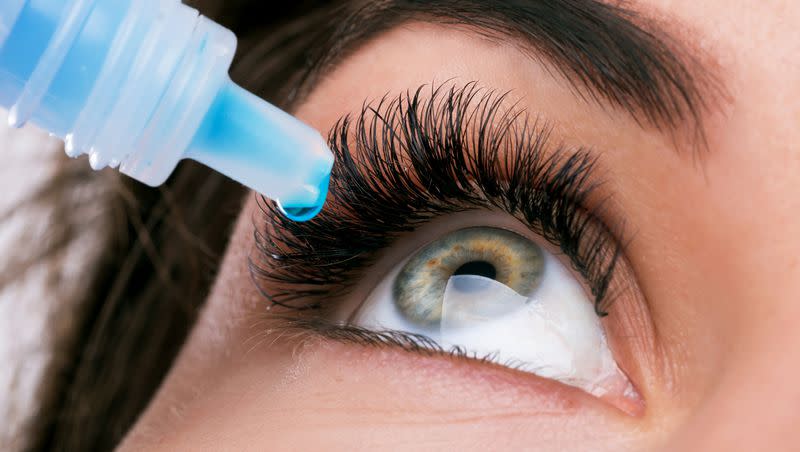Amid all the recalls, are eye drops safe to use?

Amid a plethora of eye drop recalls and don’t-use warnings, consumers could be forgiven for wondering if eye drops are safe.
The U.S. Food and Drug Administration released a list of 27 eye drop products marketed under store brand names, including CVS Health, Rite Aid, Target Up & Up and Walmart Equate, as well as Leader (Cardinal Health), Rugby (Cardinal Health) and Velocity Pharma eye drops.
“These products are intended to be sterile. Ophthalmic drug products pose a potential heightened risk of harm to users because drugs applied to the eyes bypass some of the body’s natural defenses,” the FDA said in a news release Friday.
According to NBC News, “Retailer CVS and pharmaceutical company Cardinal Health, the concern behind the eye drops sold under the Leader and Rugby brands, both said separately that Velocity Pharma LLC was the supplier. Velocity Pharma is based in Farmingdale, New York. It did not respond to multiple inquiries, including a question about where its eye drops are made.”
Safe if used properly
According to Gary D. Novack, a clinical professor of pharmacology at the University of California Davis, quoted by UCDavis Health, people should not be afraid to use eye drops. “All of these recalled eye drops should be off the shelves by now. Eye drops are sterile and safe to use. In particular. continue using your prescription eye drops as your doctor prescribed them.”
A pharmacist should also be able to tell you if a product has been recalled, he said. And the FDA website can be checked quite easily.
Jerry H. Ma, an ophthalmologist at UC Davis Eye Center, agreed in the article that eye drops, used correctly, are safe and said he often recommends artificial tears to his patients who have dry eye disease.
Per the article, he recommends preservative-free drops that come in disposable single-use vials. “So long as people use this product only once, in one or both eyes and discard, preservative-free drops are safe and a great option for dry eyes. They tend to be gentle on the eyes and can be used more frequently throughout the day,” Ma told UCDavis Health.
It’s vital, however, to stop using recalled eye drops, which could lead to infection and severe complications.
And experts say contact lens wearers are at greater risk of eye infections.
Recalls old and new
The new advisory follows an earlier recall of Pharmedica USA LLC Purely Soothing eye drops, used to reduce inflammation and help with ocular irritation, the FDA said.
And an earlier recall showed how serious eye infections can be. In that recall, eye drops were implicated in an outbreak of a drug-resistant bacteria called Pseudomonas aeruginosa. Per NBC News, “Officials from the CDC and the FDA said most of the cases could be tied to eye drops made in India and sold under the brands EzriCare Artificial Tears, Delsam Pharma Artificial Tears and Delsam Pharma Artificial Eye Ointment, all since recalled.”
Some people were blinded or had an eye removed and at least one person died.
Related
For the newest recalls, the issue is whether the products are sterile or if they could lead to infection. The FDA warned the products may contain bacteria, with the potential to cause vision loss or in extreme cases, blindness.
No infections have been reported from the products on the agency’s latest don’t-use list. But the stores are being urged to pull the products after “federal investigators found harmful bacteria and ‘insanitary conditions’ at a factory where several eye drop products are made,” as CBS News reported.
While the stores and Cardinal Health have said they are removing the eye drops from store shelves and online sales, consumers might still find them for sale somewhere. And people may have them in their cabinets at home, as well.
They should not be used.
A number of symptoms can indicate an infection from eye drops, including blurred vision, light sensitivity, eye discharge, eye irritation or discomfort, the sense that there’s something in the eye and redness and swelling of the eyelid, per the Centers for Disease Control and Prevention. Symptoms should be reported to the FDA’s MedWatch Adverse Event Reporting system. And seek medical attention.
The products in the latest warning from the FDA are:
CVS Health
Lubricant Eye Drops 15 ml (single pack).
Lubricant Eye Drops 15 ml (twin pack).
Lubricant Gel Drops 15 ml (single pack).
Lubricant Gel Drops 15 ml (twin pack).
Multi-Action Relief Drops 15 ml.
Lubricating Gel drops 10 ml.
Lubricant Eye Drops 10 ml (single pack).
Lubricant Eye Drops 10 ml (twin pack).
Mild Moderate Lubricating Eye Drops 15 ml (single pack).
Leader (Cardinal Health)
Dry Eye Relief 10 ml.
Lubricant Eye Drops 15 ml (single pack).
Lubricant Eye Drops 15 ml (twin pack).
Dry Eye Relief 15 ml.
Eye Irritation Relief 15 ml.
Rite Aid
Lubricant Eye Drops 15 ml (twin pack).
Lubricant Eye Drops 10 ml (twin pack).
Gentle Lubricant Gel Eye Drops 15 ml.
Lubricant Gel Drops 15 ml.
Lubricating Gel Drops 10 ml.
Multi-Action Relief Drops 15 ml.
Rugby (Cardinal Health)
Lubricating Tears Eye Drops 15 ml.
Polyvinyl Alcohol 1.4% Lubricating Eye Drops 15 ml.
Target
Up&Up Dry Eye Relief Lubricant Eye Drops 30 ml.
Up&Up Extreme Relief Dry Eye 15 ml (single pack).
Up&Up Extreme Relief Dry Eye 30 ml (twin pack).
Velocity Pharma
Lubricant Eye Drop 10 ml (triple pack).
Walmart
Equate Hydration PF Lubricant Eye Drop 10 ml.
